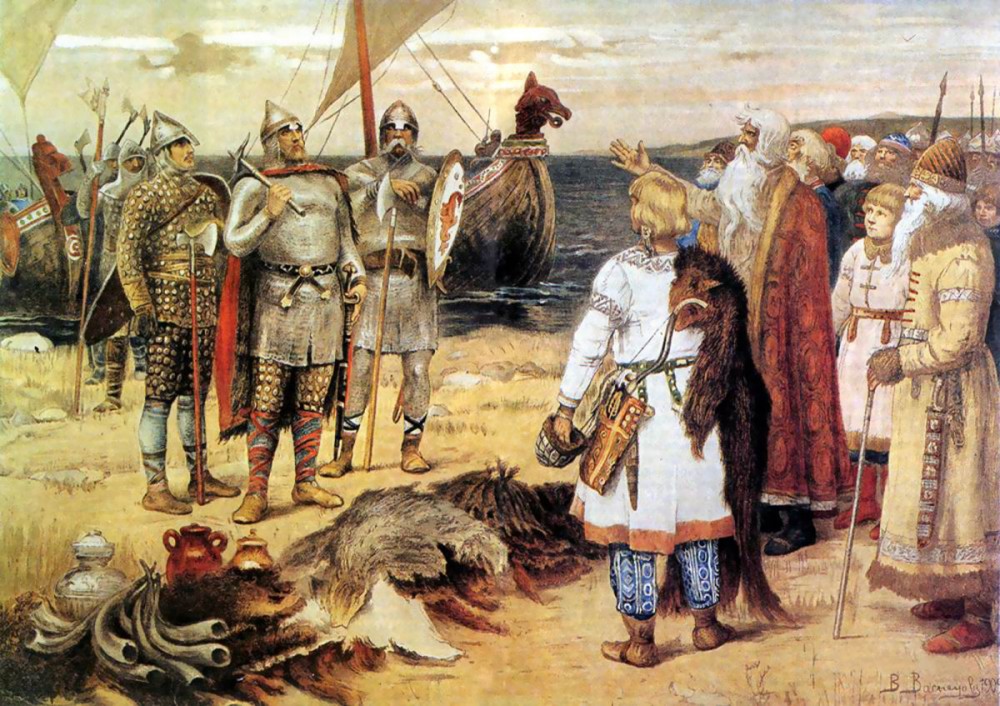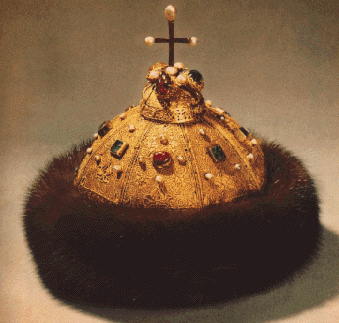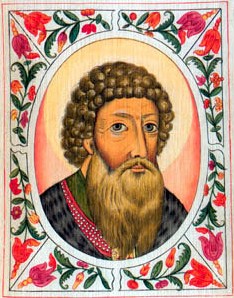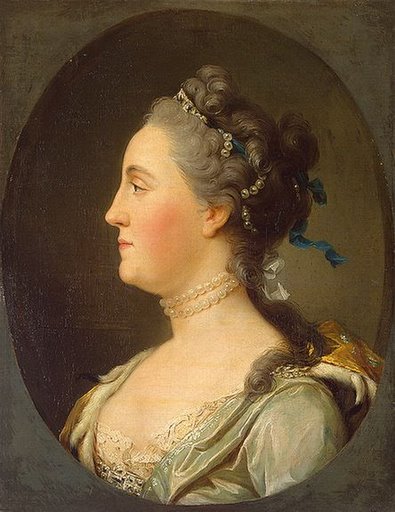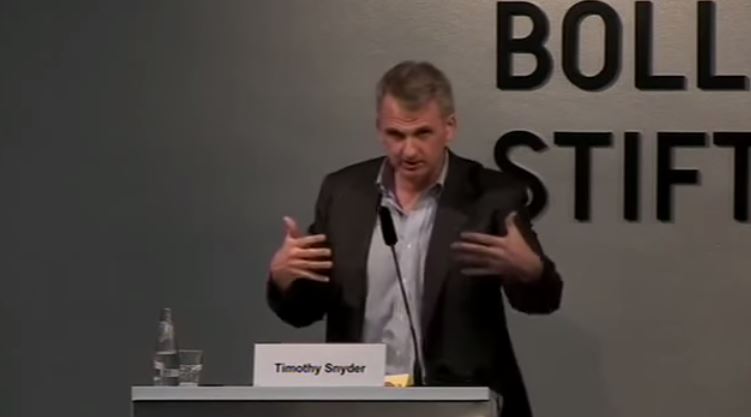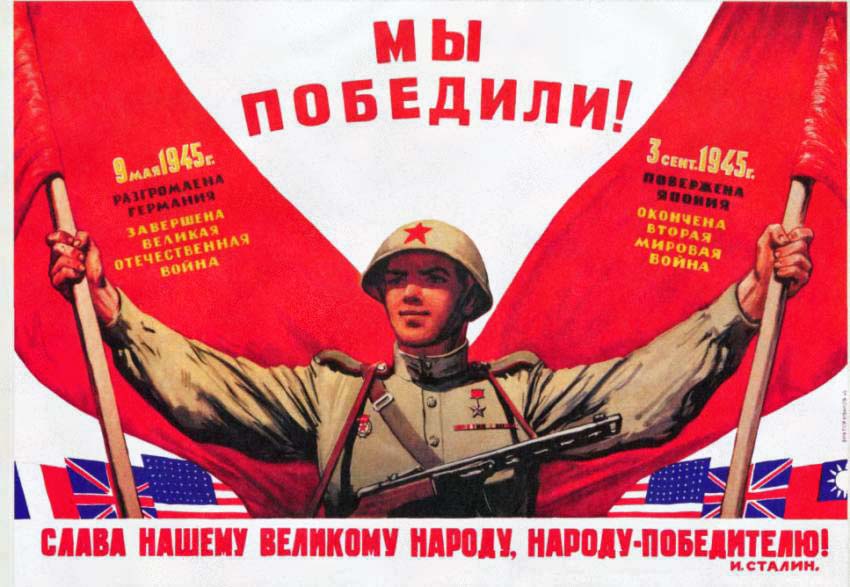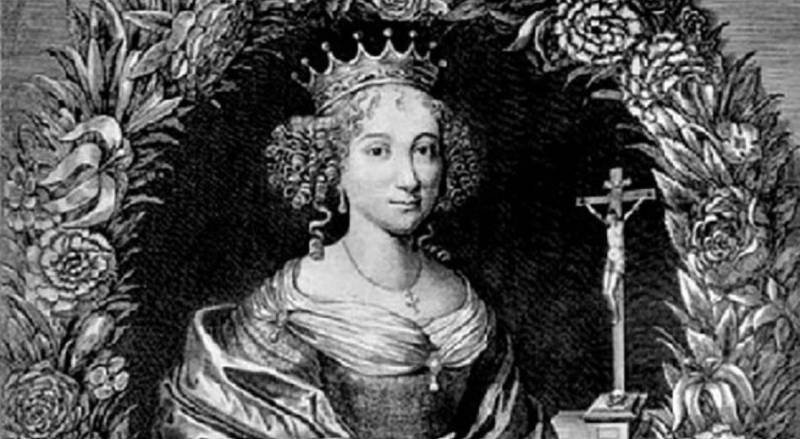In creating their nation, Ukrainians need to examine and analyze their own history, based on truth, verified facts and historical events. For centuries under the rule of conquerors, Ukrainians were basically deprived of the opportunity to influence the formation of national awareness and the development of their history, with the result that Ukraine's history was composed predominantly to the advantage of their conquerors. Especially troublesome is the question of the pretensions and demands of Moscow, and later Russia, concerning the historical legacy of Kyivan Rus.
In his historical work "The Land of Moksel or Moskovia" (Olena Teliha Publishing House, Kyiv 2008, 2009, 3 vol.) Volodymyr Bilinsky presents historical sources (predominantly Russian) which testify to the total misrepresentation of the history of the Russian Empire, which was geared to create a historical mythology about Moscow and Kyivan Rus sharing common common historical roots, and that Moscow possesses "succession rights" to Kyivan Rus.
Moscow's outright fraud that appropriated the past of the Great Kyiv kingdom and its people dealt a severe blow to the Ukrainian ethos. Our obligation now is to utilize hard facts to uncover the lies and amorality of Moskovian mythology.
Let's examine these problems.
The tsars of Moscow and, later, Russia understood that without an imposing past it was impossible to create a great nation and empire. Therefore it was necessary to glorify their historical roots and even to hijack the history of other nations. So, starting with Ivan the Terrible (1533-1584) the tsars of Moscow applied all their efforts to appropriate the history of Kyivan Rus, its glorious past, and to create an official mythology for the Russian Empire.
This might have been less consequential if their mythology had not affected the central concerns of Ukraine and if it had not aimed at the utter destruction of Ukraine: its history, language and culture. Over time, it became clear that Russian Imperial chauvinists did and continue to do everything possible to realize this aim.
Over hundreds of years and especially starting with the early XVI century, they brainwashed and continue to brainwash everyone, saying that the origins of the Russian nation and people are the Great Kyivan kingdom. They assert that Kyivan Rus was the cradle of three sibling nations - Russians, Ukrainians and Belarus; and that because the Russians are "older brothers", they have the right to the legacy of Kyivan Rus. To this day, Russian historians and officials make use of this woeful lie, which is repeated by the 'fifth column' of communists and almost all Party of Regions deputies in [Ukrainian] Parliament.

Here are the facts:
- At the time of the Kyivan Empire there was no mention of a Moscow nation. It is well known that Moscow was created in 1277 as a subservient vassal region or 'ulus' to the Golden Horde, established by the Khan Mengu-Timur. By that time, Kyivan Rus had existed for more than 300 years.
- There are no indications of any connection of Kyivan Rus with the Finnish ethnic groups in the land of 'Moksel' or later of the Moscow principality with the Principality of Kyivan Rus up until the XVI century. At the time when Kyivan Rus had officially accepted Christianity, the Finn tribes in 'Moksel' lived in a semi-primitive state.
How can anyone speak of 'an older brother' when that 'older brother' did not first appear until centuries after Rus-Ukrainians? He has no moral right to call himself an 'older brother', nor to dictate how people are to live, nor to force his culture, language, and world views. It is clear that until the end of the XV century, there was no Russian nation, there was no older brother 'Great Russian', nor were there any Russian people. Instead, there was the land of Suzdal: the land of Moksel, later the Moscow princedom, which entered into the role of the Golden Horde, the nation of Genghis Khan. From the end of the XIII to the beginning of the XVIII century, the people in this land were called Moskovites. And Moscow historians are silent about this question of their national origins.
Moskovites, 'Great Russians' - who are they?
During the IX to the XII cent. the large area of Tula, Ryazan, and today's Moscow region - all this was inhabited by the people called 'Moksel,' including the tribes of Muromians, Merya, Vepsians, Mokshas, Chudes, Maris and others. These tribes eventually became the foundation of the nation who now call themselves 'Great Russians'.

In 1137, sixth son of the Kyivan prince Volodymyr Monomakh, Yurii Dolgorukii (who had been left without a princedom in the Kyivan empire) arrived in this land.
Yurii Dolgorukii began the rule of the 'Riurykovyches' in 'Moksel', becoming prince of Suzdal. To him and a local Finnish woman was born a son Andrei, called 'Bogoliubskii'. Born and raised in the forest wilderness among the half savage Finnish tribes, prince Andrey cut all ties with his father's entourage and with their old Kyivan customs.

In 1169 Andrei Bogoliubskii sacked and destroyed Kyiv. He destroyed all the churches and religious artifacts, something unheard of in those times.
Andrei was a barbarian who did not feel any familial ties with Kyiv, the holy city of Slavs.
Within a brief time (50-80 years) every Finnish tribe was imposed with a prince of the Riurykovyches, whose mother was either a woman of Mer, Murom or Kokshan... Thus appeared the 'Moksel' princedoms: Vladimir, Ryazan, Tver, and others. At this time, some missionaries appeared in the land of Moksel to spread Christianity. It is impossible to consider a mass 'migration' of Slavs from the Dnipro river region, as Russian historians insist. Why should the Slavs leave behind their fertile Dnipro lands and relocate more than a thousand kilometers through impassable undergrowth and swamps into an unknown semi-savage land?
Under the influence of Christianity, the land of 'Moksel' started to form their language, which in time became Russian. Up until the XII century, only Finn tribes lived in the land of 'Moksel'. The archaeological findings of O.S. Uvarova (Merya And Their Everyday Life from Kurgan Excavations
, 1872 - p. 215) support this. Out of 7729 excavated kurgans, not a single Slavic burial was discovered.
And the anthropological investigations of human skulls by A. P. Bohdanov and F. K. Vovk support the differentiated characteristics of the Finnish and Slavic ethnoses.
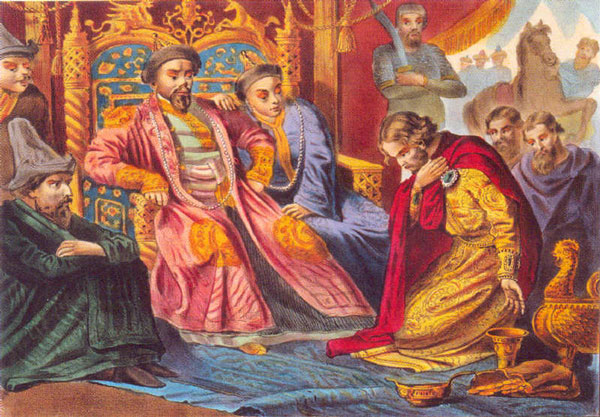
In 1237 the Tatar-Mongols entered the lands of Suzdal. All who bowed, kissed the boots of the Khan and accepted subservience remained alive and unharmed, all others who did not submit were destroyed.
The princes of Vladimir, Yurii and Yaroslav Vsevolodovich accepted subservience to Khan Batey. In this manner, the land of 'Moksel' entered the ranks of the Golden Horde Empire of Genghis Khan, and its fighting forces were combined with the army of the Empire. The commander of the Moksel division within Batey's army was Yurii Vsevolodovich, the prince of the city of Vladimir. In 1238, Finnish tribe divisions were formed and marched together under Batey in his invasions of Europe in 1240-1242. This is direct evidence of the establishment of the rule of the Khan in the lands of Rostov-Suzdal.
While Yurii Vsevolodovich was away taking part in Batey's European invasion, his younger brother Yaroslav Vsevolodovich was placed at the head of the Vladimir princedom. Yaroslav left his eight year old son Alexander Yaroslavich as hostage with the Khan.

Living with the Horde of Batey from 1238 to 1252, Alexander, only much later named "Nevsky," adopted all the customs and organizational ideas of the Golden Horde. He became a blood brother of Sartak, the son of the Khan, married the Khan's daughter, and eventually became a loyal vassal of the Golden Horde and prince of Vladimir from 1252 to 1263. He never took part in any significant battles - all the 'victories' of Alexander Nevsky are transparent lies. Prince Alexander simply could never had taken part in the battles on the Neva in 1240 and on Chud or Peipus Lake in 1242 (fantasized in Eisenstein's film) because he was still a child.
It is important to mention that the ruling powers of the local princes of Rostov-Suzdal were minimal. Khan Batey installed his own administrators in all the "ulus" princedoms: on top was the Great Baskak, and under him were the regional administrative baskaks.These were full-fledged rulers from the Golden Horde, who followed the laws of the Genghis Khans. Russian historians are lying when they state that the princes of Suzdal, and later Moscow, were independent from the Golden Horde. The Khan's covenant named the primary rulers of the princedoms his baskak, or 'daruha', while the local princes were relegated to second and even third place importance.
The big lie was introduced: that Moscow was founded in 1147 by Yuri Dolgoruky. This is a myth with no supportive evidence. Moscow was established as a settlement in 1272. That same year the Golden Horde conducted their third census of the populations in their domain. Both in the first census (1237-1238) and in the second census (1254-1259) there is no mention of any Moscow at all.
Moscow appeared as a princedom in 1277 at the decree of the Tatar-Mongol Khan Mengu-Timur and it was an ordinary 'ulus' (subdivision) of the Golden Horde. The first Moscow prince was Danila (1277-1303), younger son of Alexander so-called "Nevsky." The Riurykovych dynasty of Moscow princes starts from him. In 1319 Khan Uzbek (as stated in the afore-mentioned work by Bilinsky) named his brother Kulkhan the virtual Prince of Moscow, and in 1328 the Great Prince of Moscow. Khan Uzbek (named in Russian history as Kalita), after he converted to Islam, destroyed almost all the Riurykovych princes. In 1319-1328 the Riurykovych dynasty was replaced by the Genghis dynasty in the Moscow 'ulus' of the Golden Horde. Only in 1598 this Genghis dynasty in Moscow, which began with Prince Ivan Kalita (Kulkhan), was finally broken. Thus for over 270 years, Moscow was ruled solely by khans of the Genghis dynasty.
Still, the new dynasty of the Romanovs (Kobyla) promised to follow former traditions and solemnly swore allegiance to the age-old dynasty of Genghis.
In 1613 the Moscow Orthodox Church became the stabilizing force to safeguard the sustainment of Tatar-Mongol government in Moscow, offering masses for the Khan, and issuing anathemas on anyone who opposed this servitude.
Based on these facts, it becomes clear that Moscow is the direct inheritor of the Golden Horde Empire of Genghis and that actually the Tatar-Mongols were the 'godfathers' of Moscow statehood. The Moscow princedom (and tsardom from 1547) up until the XVI century had no ties or relationships with the princedoms of the lands of Kyivan Rus.
Great Russians
The tribe of Great Russians, or the Russian people as known today, appeared around the XV to XVII centuries from among the Finn tribes: Muroma, Mer, Ves and others. This was when their history started. There is no history of Great Russians on Kyivan lands!
The history of Great Russians starts with the 'Beyond the Forests Land' in Moscow, which was never Kyivan Rus. The Tatar-Mongols who entered these lands were a big element in the formulation of 'Great Russians'. The Great Russian psychology absorbed many characteristics - the Tatar-Mongol instincts of a conqueror and despot, with the ultimate aim: world domination.
Thus by the XVI cent. was established the type of a conqueror who was horrible in his lack of education, rage and cruelty. These people had no use for European culture and literacy. All such things like morality, honesty, shame, justice, human dignity and historical awareness were absolutely foreign to them. A significant amount of Tatar-Mongols entered the makeup of Great Russians from the XIII to XVI centuries and they accounted for the genealogy of over 25% of Russian nobility. Here are some names of Tatar/Turkic origin that brought fame to the Russian Empire: Arakcheev, Bunin, Chaadayev, Derzhavin, Karamzin, Kuprin, Plekhanov, Saltykov-Shchedrin, Tiutchev, Turgenev, Sheremetiev, and many others.
In order to appropriate the history of Kyiv lands and to immortalize this theft, the Great Russians had to squash the Ukrainian people, drive them into slavery, deprive them of their true name, exterminate them via famine, etc.
Ukrainians had emerged as a nation in the XI to XII centuries, and probably, even earlier. Later they were labeled 'Little Russians' when Russians began to brainwash the world with their 'version' of history. For the smallest deviation from this official version, people were tortured, killed, and sent off to the GULAG. The Soviet period was especially brutal and vicious. During that time, Ukraine lost over 25 million of her sons and daughters, who perished in wars for Russian interests, and during collectivization, tortures, and forced relocations.
This is the way the 'older brother' forced the 'younger brother', the 'Little Russian', to live in the savage 'embraces of love'.
Creation of the Historical Myth of the Russian State
Back in the times of the princedom of Vasily III (1505 - 1533) Moscow gave birth to the idea of its greatness, articulated by the representative of Moscow orthodoxy, the monk Filofey: "Two Romes fell, a third still stands, and there will never be a fourth".
From there, they created the idea of an all-powerful and 'God chosen' Moscow - the 'third - and final Rome'. These ideas spread and were confirmed throughout Moskovia. And how much blood was spilt by the princes of Moscow, and later the tsars, over this fantasy-myth!
During the reign of Ivan IV (the Terrible) they grasped not only after the inheritance of Kyivan Rus, but now also the Byzantine Empire. Thus, according to accounts, the "Monomakh's Cap" was believed to have been given the Kyivan prince Volodymyr Monomakh by his granddad, the basileus Constantine IX.
This was considered the symbol of the transfer of power from Byzantium to Kyivan Rus. In addition, Yurii Dolgorukii, the sixth son of Volodymyr Monomakh, was the first prince of Suzdal, so the appearance of this cap in Moscow was a 'proof' of the legacy legitimacy of the Moscow rulers not only to the Kyiv Great Throne, but now also to the inheritance of the former Byzantine Empire. Furthermore, Moscow fabricated a deceptive last will of Volodymyr Monomakh about handing over 'legacy rights' to his son Yurii Dolgorukii, the conqueror of the so-called 'Beyond the Forests Land.' This was all fiction. In reality, "Monomakh's Cap" was a gold 'Bukhara tubeteika,' which Khan Uzbek presented to Ivan Kalyta (1319-1340) who maintained this cap in order to further his fame. (Логвин Ю. Кобила, Калита і тюбетейка «Мономаха» // Час. – Київ, 1997, 27 березня).
Ivan IV (the Terrible) in 1547 was anointed in the cathedral with the title of 'Moscow Tsar' as the 'inheritor' of the Greek and Roman emperors. Of the 39 signatures who affirmed this document sent from Constantinople, 35 were forgeries. Thus, Ivan the Terrible became the 'inheritor of the Byzantine emperors'. Thus, the lie was made official.
Peter I began the massive falsification of his people's history. In 1701 he issued a decree to eliminate from all subjugated peoples all their recorded national historical artifacts: ancient chronicles, chronographs, old archives, church documents, etc. This was especially directed at Ukraine-Rus.
In 1716, Peter I 'changed the copy' of the so-called Königsberg Chronicles to now show the 'joining' of the old chronicles of the Kyivan with the Moscow princedoms. The aim was to lay a foundation for the unity of Slavic and Finnish lands. However, both the false 'copy' and the original were sealed.
Peter's falsification became the basis for further falsifications - the composition of the so-called 'General Rus Chronicles Collections' which purported to establish Moscow's rights to the legacy of Kyivan Rus. On the basis of these falsifications, on October 22, 1721, Moscow proclaimed itself the Russian Empire, and all Moskovites were now to be - Russians. In this manner, they stole from the legitimate inheritors of Kyivan Rus, the Ukrainians, historical name of Rus.
Peter imported from Europe a large number of specialists, including professional historians, who were assigned the rewriting and falsification of the history of the Russian state.
In addition, every foreigner who entered government work, swore an oath not to reveal state secrets and to never betray the Moscow state. The question remains, what government secrets regarding the 'formation of Russian history' of ancient times could there be? In any civilized European country, after 30-50 years all archives are opened. The Russian Empire is very afraid about the truth in its past. Deathly afraid!
Following Peter I, who transformed Moscow into the Russian state, the Moscow elite began to consider the necessity of creating a comprehensive history of their own country. Empress Catherine II (1762-1796) intensively took on this task.
She could not admit the idea that common Tatar-Mongol elements existed in the dynasty of the Tsars. Catherine was an intelligent and educated European woman and once she had examined the archival sources, she called attention to the fact that all the history of her country was based on oral traditions ('byliny') and had no factual support.
Therefore on December 4, 1783, Catherine II issued a decree, creating a 'Commission for the Collection and Organization of the Ancient Russian History' under the leadership and oversight of Count A. P. Shuvalov, with a staff of 10 historians. The principal task before this commission was to 'find' new chronicles, rewrite others, and create new collections of archives and other similar falsifications. The aim was to lay the foundations for the 'legitimacy' of Moscow's hijacking of the historical legacy of Kyivan Rus and to create an official historical myth about the origins of the Russian state. This commission labored for ten years. In 1792, 'Catherine's History' saw the light of day. The commission worked in the following manner:
- The gathering of all written documents (archives, chronicles, etc). This effort had partly begun under Peter I. This collection of materials was conducted not only within the Empire, but also from other countries like Poland, Türkiye etc.
- The analysis, falsification, rewritings or destruction of historical materials. Thus they rewrote the chronicles: 'The Tale of Ihor's Campaign', 'Tale of Bygone Years
', 'Lavrentiivsky Chronicles', and many others. Many chronicles were rewritten several times, and the originals were either locked up or destroyed. Thus were also locked up: the 'History of the Scythians' by A. I. Lyzlov (published in 1776 and 1787), and the 'Russian History from Ancient Times' by V. M. Tatishchev (published in 1747). In his 'Scythian History' Lyzlov showed that the inhabitants of Moscow were a separate people, who had nothing in common with Kyivan Rus, Lithuania, Poland, etc.
- The writing of new 'Rus Chronicles Collections
' which were now being composed in the XVIII cent., but purported to be from the XI to the XIV centuries. These collections all propagated the 'General Rus' idea. This was in reference to the times when Kyivan lands were inhabited by Slavic tribes (the Polans, the Drevlians, the Severians, and others) who were Christians, while the 'Beyond the Forests Land' was populated by Finn tribes (the Muromians, the Merya, the Vepsians, the Mokshas, and others) who lived a semi-primitive existence, and these tribes had nothing historical in common up to the XVI century.
- The new composition of thousands of various collections to establish the 'unity' of Kyivan Rus with the Finn tribes. All these chronicles and collections, according to author Bilinsky, exist only in the form of copies, not one original. Not one! All this points to the almost unbelievable in scope and shameless, massive plundering and falsification of the creation of the history of the Russian state.
It is impossible to live a lie forever!
It is time for Ukrainian historians to write the actual true history of Ukraine, which would not be based on the lies of the 'Catherine's Chronicles', the falsifications and newly written in the XVIII century 'General Russian Chronicle Collections', but rather based on historical reality, established in documents, especially those preserved in countries like Poland, Türkiye, Greece, Iran and others. People deserve to know the truth.
Related:
- Symbolic expansion: how Putin annexes history, not only territories
- Anna of Kyiv, the French Queen from Kyivan Rus
- Putin’s ‘appropriation’ of medieval Ukrainian princess reflects more than historical arrogance
- Kings or Princes? Why Do the Titles of Rusian Rulers Matter
- Ukrainian conflict is between ‘heirs of Kyivan Rus’ and ‘heirs of Golden Horde’
- Princess Olha of Kyiv: a golden page in Ukrainian history
- Ukraine and Russia “share a long and common history” FAQ
- Stolen ancient viking’s sword from the dawn of Kyivan Rus comes back home to Ukraine
- Tatar historian: ‘Russians are no more European than are the Tatars’
- Why there are Muslim crescents on Orthodox crosses in Moscow but not in Kyiv
- Ukrainian parliament mulls requiring officials to call the Russian state ‘Muscovy’

